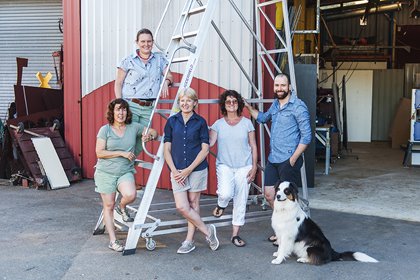 Community Structure: Sculptors at Work
Community Structure: Sculptors at Work
Words by Hannah Muir
Tucked away in the industrial area of O’Connor is a hive of activity wrapped in a warehouse. On arrival, the bold work of sculptor Tony Jones that stands before the entrance immediately signals that art lives here. The Artsource O’Connor Studio, which also goes by the name of the Dickmann Studios, provides a creative space for six local sculptors pursuing their own artistic trajectories while revelling in the wealth that comes from shared space and ambitions.
The space, which offers exceptionally high roofing, gantries and a large outdoor-concreted area, is perfect for artists working with trade-like processes. The studio is honest to its warehouse origins with a ‘no frills’ feel that instantly suggests that this place means business and so do its residents. Angela McHarrie, Karen Millar, Pascal Proteau, Lisa Dymond and Sarah Wilkinson along with Tony Jones have developed the space into an area that is conducive to the production of their sculptural medium with a true and charming sense of community.
The large and expansive floor plan offers individual work nooks centred round a larger shared space.
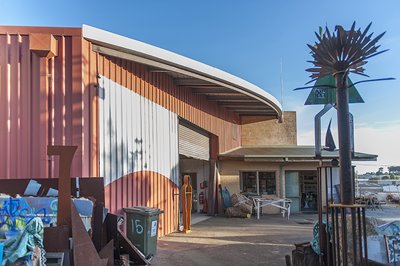
The fine film of productivity-related dust that has fallen on works in progress, materials, tools and machinery assures you that this space is used well.
Before reaching the heights of the roller door entry, a long, slight building connects to the warehouse, housing a collection of Karen Millar’s delicate ceramic work, juxtaposed in form and appearance with the grand structures created in the main space. From the outset there is an impression that the artists are all working with different mediums, different tools and different schedules in what appears to be chaotic harmony.
Although Karen Millar works predominantly in the smaller offshoot of the studio, the warmth of the kiln, which is situated in the larger warehouse, is widely welcomed during the winter months. Mostly building sculptural forms from paper, fabric, wire, wood and clay, Millar’s work is a gentle analysis of the relationship between decay and death, growth and renewal. The results, which evoke a sense of calmness, are reminiscent of precious natural relics.
In contrast to the crisp ‘newness’ of materials used by Karen Millar, the sculptural work of Lisa Dymond often conjures up new beginnings for unlikely supplies, breathing life into clothing, kitchen appliances and other found objects as well as working with laminated marine ply and aluminium. Lisa’s work is a commentary on society and asks us what is it to be human or, more simply, ‘have you noticed this?’ For example, in her piece Upsizing (2015) Dymond reflects the Australian trend of constantly up-scaling property, likening it to the process of hermit crabs shedding former shells for roomier upgrades.
Angela McHarrie said her artistic motivation is drawn from life in general and not necessarily inspired by anything other than, “random, useless information.” Across her career McHarrie’s work has varied in scale from small three-dimensional objects to many huge public art installations. The fluidity of her aesthetic is consistently evident and demonstrated down to the finest details of every work. Currently, she is working with marble, bronze, timber, steel and cast hydrostone. “Materials and aesthetic are really important to me,” McHarrie said. “The actual process of making the work and the materiality of it is really important to the finish.”
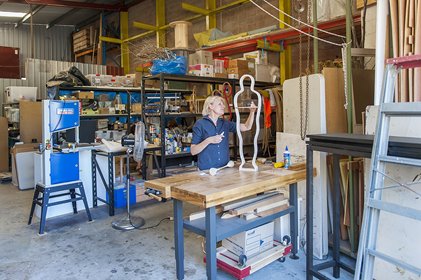 Sarah Wilkinson’s current fascination is playing with her audience’s ears as well as eyes. “I have always had a passion for live theatre and performance,” she said. Through Baroque theatre mechanisms and scenic effects, Wilkinson produces sound illusions of rain, wind and thunder, resulting in small and intimate works.
Sarah Wilkinson’s current fascination is playing with her audience’s ears as well as eyes. “I have always had a passion for live theatre and performance,” she said. Through Baroque theatre mechanisms and scenic effects, Wilkinson produces sound illusions of rain, wind and thunder, resulting in small and intimate works.
“Quite often the sound can be bigger than the work itself,” she explained, adding that she uses old techniques to imagine a new future. Wilkinson encourages her audience to physically interact with gadgets in her work. “There is an engagement that is different to pressing a button or turning a switch on,” she said. “It provides a moment to slow down, a chance to reflect, it’s tactile and a little bit mysterious, and everyone can make it happen.”
Working predominantly with timber, Pascal Proteau also uses a lot of found objects, giving them a new beginning and significance. He is currently pursuing ideas that are born from personal experiences. “My intention is to create works that have an impact on the viewer, that generate feelings and connection above thoughts,” he said. More specifically, the two subjects currently at the forefront of Proteau’s practice are urban expansion and the stigma of mental health issues.
“Nature has always been of the most importance for me and is where I find my inspiration,” he said. “To see and realise the way we humans take it for granted is extremely sad.”
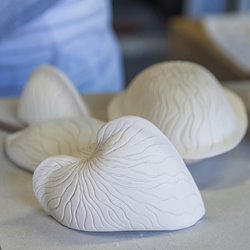 Proteau is eloquent about the benefits of working within a shared space with like-minded artists. “We have seen one another develop, discover and grow as artists in our practices,” he explained.
Proteau is eloquent about the benefits of working within a shared space with like-minded artists. “We have seen one another develop, discover and grow as artists in our practices,” he explained.
“There is a beautiful openness between us all, to share materials, techniques, ideas, critiques and at time, moral support.”
This sentiment is well shared amongst the artists.
“TAFE was a way that people made connections and friendships,” said Karen Millar, explaining that all of the O’Connor artists knew each other through Central TAFE as either students or lecturers. “We all work in different mediums so there is the ability to cross-pollinate with techniques and ideas,” Millar added. “We have exhibited together more than once and that shared component is an important part (of the space).”
Lisa Dymond said the interaction means she often prefers to be at the warehouse despite its heat in summer and even though her home studio provides a much cooler working environment. “It’s having like-minded people around, even if you’re not on the same project,” she said. “The times that you get stuck and the times when everything else implodes on your creative space, you can talk about those things, which can help see a way forward.”
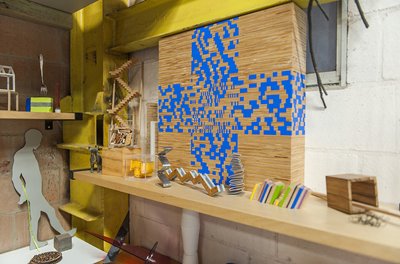 Along with this support and encouragement, Angela McHarrie adds that studio colleagues provide a valuable forum for critical feedback, although Millar points out that the conversation is invited. “You invite someone to comment or critique at a time that you are prepared for it, it’s very respectful. Everyone is generous in that way. You get more excited to see the work in other people’s space than you do your own,” she said.
Along with this support and encouragement, Angela McHarrie adds that studio colleagues provide a valuable forum for critical feedback, although Millar points out that the conversation is invited. “You invite someone to comment or critique at a time that you are prepared for it, it’s very respectful. Everyone is generous in that way. You get more excited to see the work in other people’s space than you do your own,” she said.
Although far removed from the formal education of TAFE, the mutual space offers great possibility for sharing skills and knowledge. The artists have the opportunity to constantly learn from their peers and keep updating their techniques. At a practical level the studio shares a spot welder, a mig welder, welding screens, a compressor, some storage racking and dust extractor. On top of this, the extensive inventory of the artists’ individually owned gear is frequently shared amongst the group.
All acknowledge the enormous value of having Tony Jones in the mix. Jones has been an influential figure in Western Australian sculpture for decades. In 2015 he retired after 50 years of teaching sculpture, including 36 years at TAFE, first at the former Claremont School of Art and then at the Central School of Art, now North Metropolitan TAFE. In November last year he turned to social media to publish a powerful open letter to the Hon Liza Harvey, Minister for Training and Workforce Development expressing his distress that the ‘wheels are falling off’ the unique and very fine training that had been developed at TAFE.
Apart from what Tony Jones now adds to the O’Connor environment as an artist and valued mentor, Millar highlights that Tony’s integration in the art community and his long history of teaching means that many former students and artists are coming and going from the place. “People are constantly coming in and out and are often interested in how it (the studio) works and why it works,” she said.
In fact the O’Connor studio has evolved into an informal ‘drop in’ for fellow creatives.
It isn’t unheard of for a curator who’s meeting with one artist to take the opportunity to see many more works.
Collaborations between the studio artists have arisen this way. “That’s driven by the curator of the particular exhibition,” McHarrie said. “They will quite often have an over arching theme that we then respond to in our own individual way.” She cites the 2015 Handle With Care exhibition at Heathcote Museum and Gallery as an example. It encouraged the artists to examine, ‘the notion and intersection of fragility and strength’[1]. According to McHarrie, “Everyone responded to it in quite a different way.” The resulting works featured timber, ceramics, kinetic metronomes, sound machines and drawing.
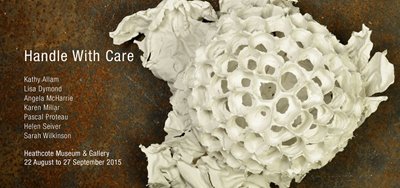 Currently, collective sights are set on the 2017 Sculptures at Bathers, which opens on February 25 in the West End of Fremantle. All of the O’Connor studio residents are involved. Since its inception four years ago, the dedicated volunteer crew that has pursued the initiative has developed it into a true celebration of Western Australian sculpture. McHarrie has been integral to the organisation and execution of the event since the beginning. Now she is focussed on its future.
Currently, collective sights are set on the 2017 Sculptures at Bathers, which opens on February 25 in the West End of Fremantle. All of the O’Connor studio residents are involved. Since its inception four years ago, the dedicated volunteer crew that has pursued the initiative has developed it into a true celebration of Western Australian sculpture. McHarrie has been integral to the organisation and execution of the event since the beginning. Now she is focussed on its future.
“There’s a real opportunity to create a sculptural hub by exhibiting all through that area of Fremantle,” she said. “Ultimately in 2019 we would like to look at the opportunity of having an exhibition at the Moores Building and to be talking to the (Fremantle) Arts Centre.”
It isn’t only the exhibited pieces that can be classified as labours of love in this major event. Sculptures at Bathers runs on the smell of an oily rag, with only one paid staff member on a small contract. “It’s got a massive volunteer base… everything from the install team to the whole 16 person committee who have been working now for 18 months to bring this show together. Recently it was quantified as 14,000 hours, it’s a huge commitment on behalf of people. I think they feel so passionate about it.”
These hours only include the skilled volunteers who organise the event. There are several volunteer students who provide the busy beach patrol team on top of that.
It’s clear that the collective effort to get the event off the ground and the results that they have achieved with Sculptures at Bathers generates a great sense of pride among the practitioners.
“There is a sense of belonging that there isn’t with other shows,” Millar said, again acknowledging the pivotal role of Tony Jones who has been at the heart of the initiative throughout. “I guess because we have all been taught by him at some time. There is that awareness of his generosity and how he works and how he gives back to the community,” she explains, adding that the impetus behind the event’s inception was to promote local artists. “That’s why we got it going in the first place. It’s doing really well now.”
The event has become so popular that this year all contributing artists have been specifically invited, moving away from the open call out of previous years.
“It’s now got to the point that we have had such a phenomenal and positive response to the initial invitations that we were up to maximum numbers before we even opened it to anyone else,” said McHarrie. “How we deal with that in the future I’m not too sure.”
The free event, which showcases over 80 Western Australian artists, is an incredible cultural treat for Fremantle and the wider community. It highlights the vibrance and breadth of sculptural practice in this state.
As McHarrie attests, “When it’s all up and running it’s amazing.”
Hannah Muir grew up in Fremantle, graduated from Murdoch University in 2012 and then took up work at Ngukurr Art Centre in South East Arnhem Land. She now resides in Alice Springs and works in community development with the Tangentyere Aboriginal Council.
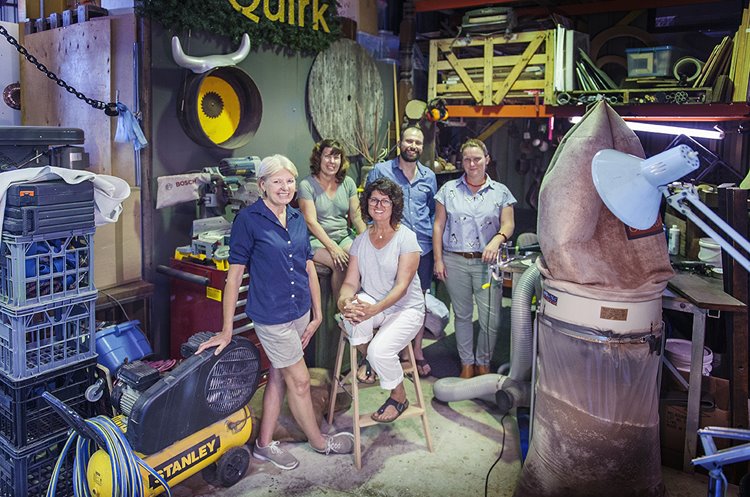
IMAGES top to bottom:
-
Lisa Dymond, Sarah Wilkinson, Angela McHarrie, Karen Millar and Pascal Proteau at Artsource O'Connor Studios, 2017. Photographer: Christophe Canato
-
Karen Millar, works in studio, Artsource O'Connor Studios, 2017. Photographer: Christophe Canato
-
Angela McHarrie in her Artsource O'Connor Studio, 2017. Photographer: Christophe Canato
-
Angela McHarrie's work in studio, Artsource O'Connor Studios, 2017. Photographer: Christophe Canato
-
Handle With Care exhibition flyer, Heathcote Museum and Art Gallery, 2015.
-
Angela McHarrie, Lisa Dymond, Karen Millar, Pascal Proteau and Sarah Wilkinson at Artsource O'Connor Studios, 2017. Photographer: Christophe Canato